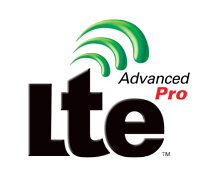LTE Advanced
LTE Advanced (Long-Term Evolution Advanced) is a standard for wireless broadband communication for mobile devices and data terminals, based on the GSM/EDGE and UMTS/HSPA technologies. It increases the capacity and speed using a different radio interface together with core network improvements. LTE Advanced is a major enhancement of the Long-Term Evolution (LTE) standard developed by the 3GPP (3rd Generation Partnership Project) and was formally submitted as a candidate 4G system to ITU-T in late 2009. It was approved into ITU’s IMT-Advanced family of standards in 2010, which defines the requirements for 4G capabilities.
Overview[edit | edit source]
LTE Advanced aims to improve the LTE standard to cope with future requirements of higher data rates and connectivity. It introduces several significant enhancements over LTE, including carrier aggregation (CA), enhanced use of multi-antenna techniques, and support for relay nodes. These improvements enable LTE Advanced to offer peak data rates of up to 1 Gbps for downlink and 500 Mbps for uplink, which represent a significant leap over the original LTE capabilities.
Carrier Aggregation[edit | edit source]
One of the key features of LTE Advanced is carrier aggregation (CA), which allows the combination of multiple LTE carriers into a single data channel to increase the peak data rates and overall capacity of the network. This technique enables more efficient use of the available spectrum.
MIMO[edit | edit source]
LTE Advanced also expands the use of MIMO (Multiple Input Multiple Output) technology, which involves using multiple antennas at both the transmitter and receiver ends to improve communication performance. LTE Advanced supports up to 8x8 MIMO in the downlink and 4x4 MIMO in the uplink, enhancing the capacity and reliability of wireless communications.
Relay Nodes[edit | edit source]
The introduction of relay nodes is another enhancement in LTE Advanced. Relay nodes are low power base stations that provide improved coverage and capacity at the cell edge, and in areas where direct communication with the main cell base station is inefficient.
Deployment[edit | edit source]
The deployment of LTE Advanced is ongoing worldwide, with many operators upgrading their networks to support the enhanced capabilities of the standard. The transition to LTE Advanced is seen as a critical step for operators to meet the growing demand for mobile data and to prepare networks for the future introduction of 5G technologies.
Compatibility[edit | edit source]
LTE Advanced is backward compatible with LTE, ensuring that existing LTE devices and networks can continue to operate and benefit from the enhanced performance of LTE Advanced where available.
Challenges[edit | edit source]
Despite its advantages, the deployment of LTE Advanced faces several challenges, including the need for significant investment in network infrastructure and the complexity of implementing advanced technologies such as carrier aggregation and MIMO. Additionally, ensuring widespread coverage and device compatibility remains a challenge for network operators.
Conclusion[edit | edit source]
LTE Advanced represents a significant step forward in the evolution of mobile broadband, offering substantial improvements in speed, capacity, and efficiency. As the demand for mobile data continues to grow, LTE Advanced and its further enhancements will play a crucial role in providing the necessary network performance to support future mobile services and applications.
Search WikiMD
Ad.Tired of being Overweight? Try W8MD's physician weight loss program.
Semaglutide (Ozempic / Wegovy and Tirzepatide (Mounjaro / Zepbound) available.
Advertise on WikiMD
|
WikiMD's Wellness Encyclopedia |
| Let Food Be Thy Medicine Medicine Thy Food - Hippocrates |
Translate this page: - East Asian
中文,
日本,
한국어,
South Asian
हिन्दी,
தமிழ்,
తెలుగు,
Urdu,
ಕನ್ನಡ,
Southeast Asian
Indonesian,
Vietnamese,
Thai,
မြန်မာဘာသာ,
বাংলা
European
español,
Deutsch,
français,
Greek,
português do Brasil,
polski,
română,
русский,
Nederlands,
norsk,
svenska,
suomi,
Italian
Middle Eastern & African
عربى,
Turkish,
Persian,
Hebrew,
Afrikaans,
isiZulu,
Kiswahili,
Other
Bulgarian,
Hungarian,
Czech,
Swedish,
മലയാളം,
मराठी,
ਪੰਜਾਬੀ,
ગુજરાતી,
Portuguese,
Ukrainian
Medical Disclaimer: WikiMD is not a substitute for professional medical advice. The information on WikiMD is provided as an information resource only, may be incorrect, outdated or misleading, and is not to be used or relied on for any diagnostic or treatment purposes. Please consult your health care provider before making any healthcare decisions or for guidance about a specific medical condition. WikiMD expressly disclaims responsibility, and shall have no liability, for any damages, loss, injury, or liability whatsoever suffered as a result of your reliance on the information contained in this site. By visiting this site you agree to the foregoing terms and conditions, which may from time to time be changed or supplemented by WikiMD. If you do not agree to the foregoing terms and conditions, you should not enter or use this site. See full disclaimer.
Credits:Most images are courtesy of Wikimedia commons, and templates Wikipedia, licensed under CC BY SA or similar.
Contributors: Prab R. Tumpati, MD





